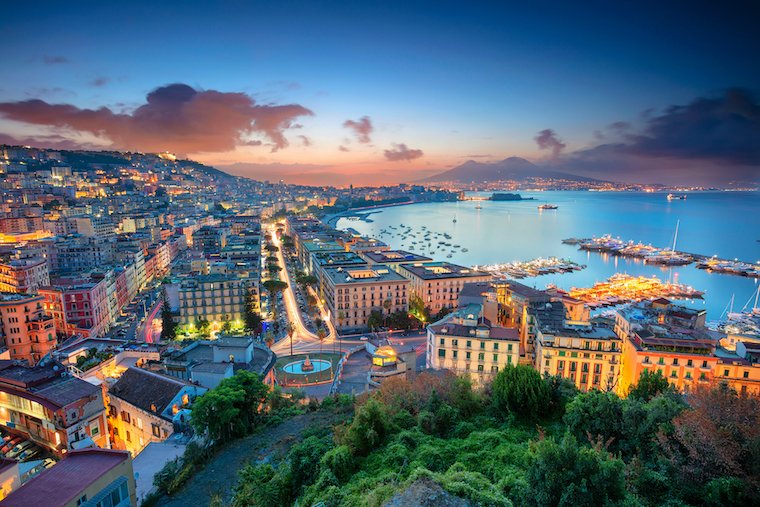A small balcony among the rocks overlooking the sea, a tangle of narrow streets and stairs that climb and mingle with one another, a continuous surprise of enchanting views and visions. This is Atrani, a small village on the Amalfi Coast, one of the most beautiful in Italy, an absolute must on your trip to Campania.
Atrani

Atrani is a tiny village on the Amalfi Coast, the smallest municipality in Italy by extension, located in the province of Salerno. The village extends over the valley of the Dragone river and lies entirely between Monte Civita and Monte Aureo. The upper part lies on the top of the hill and slopes gently down to the beach. The focal point of the village is the small square overlooked by the Church of San Salvatore, a small and characteristic widening surrounded by a sort of courtyard made up of old houses: from this point you can access the marina, with its small and beautiful beach with limpid waters. Lastly, the road open to traffic wraps around the village like a ribbon going from the bottom to the top, making it easily accessible to travellers, while inland, the mundane life stops in the presence of the nature of the place, where the citrus groves release their perfumes and paint the landscape with their colours, bright and vivid in almost every season of the year.
Atrani is a village that amazes, a place that enchants and 'traps' the traveller in the beautiful intricate alleyways, in the climbs and stairways, in the sheer drop to the sea and in the tangle of dwellings that almost overlap one another. If you are in Atrani, you cannot help but enjoy its evocative scenery at all times of day and during every season of the year. The village's many churches are also worth a visit, including that of San Salvatore de Briecto, with its distinctive Renaissance façade and clock and its late 11th-century marble pluteus inside. This is a symbolic building: in ancient times, it hosted the coronation of high officials wearing the typical doge's cap ('birecto'). The Collegiate Church of Santa Maria Maddalena with its dome and bell tower is also a remarkable building, as is the ancient church of San Michele Arcangelo known as the 'Camposantino' located on the border with Ravello. Other points of interest are Masaniello's cave where, according to legend, Masaniello took refuge, wanted by the viceroyal army, and his house, in the immediate vicinity, which actually belonged to Masaniello's maternal family. Last but not least, we would like to mention the Ziro Tower located between Atrani and Amalfi, which, according to popular tales, was the prison of Queen Giovanna, known as the madwoman. Lovers of trekking and excursions can explore nature trails by reaching some nearby towns on foot (such as Amalfi) or they can easily travel to some of the most beautiful neighbouring towns on the Coast such as Ravello, Maiori or Furore to enjoy wonderful atmospheres and breathtaking views.
In a characteristic seaside village like Atrani, the local cuisine is almost entirely based on fresh fish, blue fish in particular, shellfish and seafood. Just as in the neighbouring coastal towns, here too you can enjoy excellent grilled fish or seafood soups and the inevitable spaghetto or scialatiello allo scoglio, prepared to perfection by local restaurants and trattorias. Dairy products and cheeses from the hills and mountains of the hinterland will delight you with their flavours, sometimes delicate, sometimes stronger and more decisive, and you can accompany them with a glass of red wine produced in the neighbouring towns (a Tramonti, for example). One of the absolutely typical dishes is, then, the Sarchiapone, or elongated green pumpkin cylinder, fried, stuffed with minced meat, mozzarella, cold cuts and cheese, all dressed with a tasty tomato sauce. As for desserts, here Neapolitan pastry meets that of the Amalfi Coast and you will find plenty of choice between babà, classic sfogliatella and Santa Rosa, as well as lemon delights, ricotta and pear cakes, not forgetting pasticciotto atranese or bocconotto, a short pastry filled with lemon cream (the typical sfusato amalfitano) and amarena cherries. There is no shortage of liqueurs: limoncello is unfailing, but lauro and fragolino, with their interesting flavour and aroma, are also characteristic.
One of the most evocative and magical periods to be experienced in Atrani is certainly Christmas: illuminations colour the village, which becomes a characteristic, romantically seafaring nativity scene. In this scenario, events are organised, with the most beautiful moment taking place at midnight on 24 December with the Calata della Stella (Descent of the Star), when a grandiose firework display reproduces the descent of the comet star from Mount Aureo, in a 'firework display' of fireworks with incredible colours and effects. At Easter, on Maundy Thursday to be precise, there is the traditional Way of the Cross with clappers, a real performance with theatrical tones, strongly involving. On 4 June it is the turn of the Corteo delle Repubbliche Marinare (Maritime Republics Procession), a costume event retracing the splendid mediaeval period when Atrani, twinned with Amalfi, was a rich and flourishing seafaring village: the procession, in fact, starts from Atrani and arrives as far as Amalfi. In July and August, the village is invaded by musical events and concerts, while from 19 to 22 July (and then from 20 to 23 September) Santa Maria Maddalena is celebrated. But it is in August that the flavours of the village are the stars, with the much-awaited Sagra del pesce azzurro (Festival of Blue Fish), a not-to-be-missed opportunity to taste all the traditional local foods. Medieval atmospheres return, then, from 31 August to 1 September, during the Byzantine New Year (a costumed event held between Amalfi and Atrani) that re-enacts the beginning of the fiscal and legal year at the time of the Byzantine era, an exciting and evocative event that every year enjoys a large audience that flocks in from various towns in Campania.
